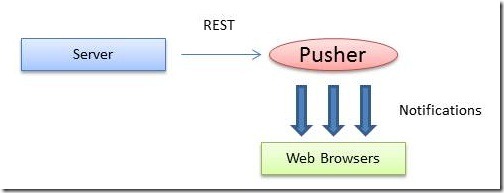To push, or not to push, the Web Socket dilemma
Web Sockets is a relatively new specification introduced as part of HTML 5 to support a full duplex-communication channel over http in web browsers. This represents a great advance toward real-time and event driven web applications. Before Web Sockets jumped in scene, the only available solutions for emulating real time notifications in web applications were different variants of Http Long polling. Real time notifications in this context became particularly important for specific scenarios, such as reporting stock pricing updates, online gaming or news reports to name a few.
All the Http polling variants were pretty much similar in nature. They all try to emulate a bidirectional connection over http by keeping client connections open for a period of time until some notifications becomes available and can be sent as part of the response or the connection times out. However, these techniques usually require the use of two connections for streaming data to and from the client. Another common issue with this approach is that developers need to implement the server side carefully to make an efficient use of the server resources.
There is, however, an area where Http polling has proved to very effective over the years, and that is pub/sub. We can find in this area simple usages of pub/sub over http like syndication feeds or more complex solutions for business to business integration, but as you can see, they are not related to real time notifications in a web browser at all.
Web Sockets on the other hand is going to be supported natively on any web browser compliant with HTML 5, so removing the need of relying on different workarounds with HTTP Ajax and timers for emulating real time notifications in the browser. As I said before, the specification is relatively new so the support you find today in all the major browsers is partial or incompatible in some cases. However, I am pretty sure Web Sockets will become the standard technology for pushing real time data to web browsers in the upcoming years.
Web Sockets in Detail
The Web Socket interface definition according to the spec looks as follow,
[Constructor(in DOMString url)]interface WebSocket {readonly attribute DOMString URL;// ready stateconst unsigned short CONNECTING = 0;
const unsigned short OPEN = 1;
const unsigned short CLOSED = 2;
readonly attribute int readyState;
// networkingattribute EventListener onopen;
attribute EventListener onmessage;
attribute EventListener onclosed;
void postMessage(in DOMString data);
void disconnect();};
As you can see, this API is very straightforward and simple to use. There is a constructor you can use to create a new Web Socket instance or connection, a callback for receiving messages (onmessage) and two additional methods for sending new messages (postMessage) or close the socket instance (disconnect) respectively. .
A Web Socket connection is established by upgrading from the HTTP protocol to the Web Socket protocol during an initial handshake between the client and the server, over the same underlying TCP/IP connection. Once the connection is established, the data can be sent back and forth between the client and the server in full-duplex mode. Here is how you create a new Web Socket connection in the browser,
var mySocket = new WebSocket("ws://weblogs.asp.net/cibrax");
The “ws” prefix indicates a Web Socket connection. There is also a “wss” prefix for secure connections. Once the connection has been opened, you can associate a handler for the “onmessage” event for start receiving messages,
mySocket.onmessage = function(evt) { alert( "Message Received: " + evt.data); };
Or send messages with the “postMessage” method,
mySocket.postMessage("Hello World!!!!");There are a couple of implementations already in .NET for implementing the server side part required for pushing notifications, and some of there are Nugget (Not really a good name for an open source project given the existing NuGet project from Microsoft) or Fleck. The WCF team is also working on an implementation as part of the WCF Web Apis framework and you can see some announcements here.
Web Sockets in the Cloud
There is a particular implementation in the cloud that caught my attention in the last few months, and that is “Pusher”. “Pusher” is a service hosted in the cloud that provides all the service side infrastructure for pushing notifications to the different clients (browsers running in all kind of devices or personal computers) using web sockets if it is available or a flash-based socket communication otherwise.
Your server code publishes notifications in an specific “Pusher” channel using a simple REST Api, and they take care of broadcasting the notifications to all the subscribers for that channel. They provide a javascript API that you can use in a web page for subscribing to a channel, and the REST API for publishing messages on the server side. There is also different open source implementations for wrapping up the REST API in a simple object model, and you can find here for example to “PusherDotNet”, a .NET implementation in C#. The pricing model is also very easy to understand, you pay for a flat rate that gives you access to a specific number of messages and connections per day.
